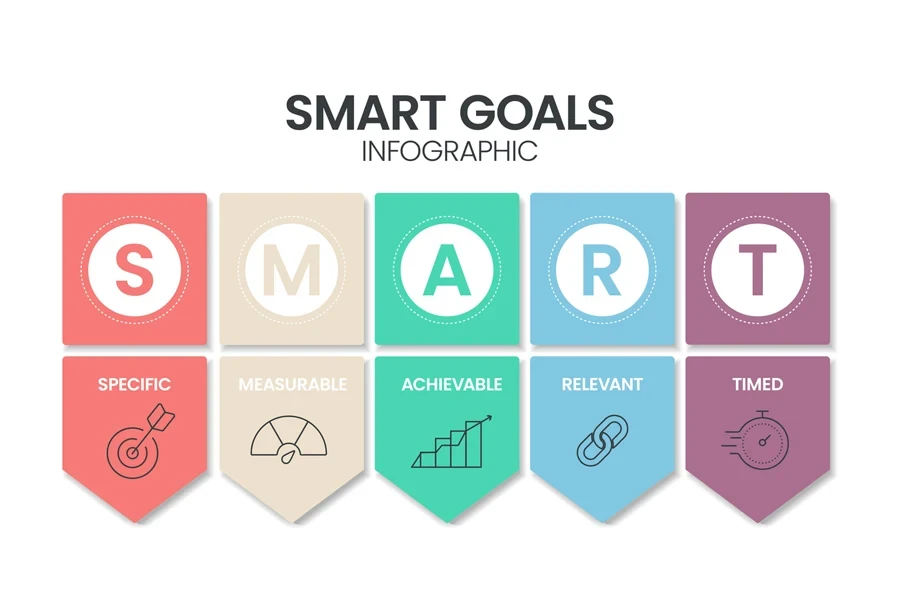Setting strategic business goals is not just a tradition; it’s a cornerstone of success in the rapidly evolving digital marketplace, and the new year is a great time to start thinking about it if you haven’t already. If you have, it may be time to revisit your goals to see if you’re hitting the benchmarks you set or if you need to adjust.
Here, we’ll delve into the importance of reviewing your e-commerce business, setting actionable goals, and crafting a roadmap for the future to ensure growth and prosperity in the year ahead.
Table of Contents
Why are business goals important?
Steps to setting effective business goals
Final thoughts
Why are business goals important?
Clear goals are more than just a good idea; they are essential for success. But why are business goals so important?
- Direction and focus: Goals provide a clear direction for the business, guiding decision-making and resource allocation. They help focus efforts and resources on activities aligned with the company’s objectives, minimizing distractions, and maximizing productivity.
- Success measurement: Goals serve as benchmarks for measuring the success and progress of the business. Businesses can track their performance over time by setting specific, measurable targets and assessing whether they are moving closer to the desired outcomes.
- Motivation and engagement: Defined goals can inspire and motivate employees, driving engagement and commitment to achieving shared objectives. When employees understand how their contributions contribute to broader business goals, they are more likely to feel a sense of purpose and ownership in their work.
- Resource allocation: Setting goals helps businesses prioritize their resources, including time, money, and talent, to support activities most critical to achieving desired outcomes. By identifying key priorities and allocating resources accordingly, businesses can optimize efficiency and effectiveness.
- Risk management: Goals enable businesses to anticipate risks and challenges and develop strategies to mitigate them. By setting realistic and achievable goals, businesses can identify potential obstacles and develop contingency plans to address them, minimizing the impact of unforeseen challenges on their operations.
- Strategic alignment: Business goals ensure alignment between various departments, teams, and individuals within the organization. Collaboration and communication are enhanced when everyone is working towards common objectives, leading to greater synergy and cohesion across the organization.
- Adaptation and innovation: Setting goals encourages businesses to adapt to changing market conditions and embrace innovation. By regularly reviewing and adjusting goals in response to external factors and internal performance, businesses can stay agile and responsive to emerging opportunities and threats.
Steps to setting effective business goals

So, now that you know exactly how setting strategic goals can benefit your business, here are the steps to set effective business goals and achieve them.
1. Reflect on your business
Before setting your sights on the future, taking stock of where your e-commerce business stands today is essential. Reflecting on the past year’s successes, failures, and lessons learned provides valuable insights to inform your strategic decisions.
Dive deep into your business metrics, analyzing key performance indicators (KPIs) such as sales revenue, conversion rates, customer acquisition costs, and retention rates. Identify areas of strength and weakness to lay a solid foundation for goal setting and planning.
A SWOT analysis is a strategic planning tool businesses use to assess and understand their internal Strengths and Weaknesses as well as external Opportunities and Threats. Learn how and when your business should conduct a SWOT analysis, as well as what actionable steps to take after the analysis.
Understand your customers
In addition to reviewing your business metrics, it’s crucial to understand your customers’ needs, preferences, and behaviors. Leverage data analytics tools to uncover valuable insights about your target audience, including demographics, purchase patterns, and product preferences. Understanding your customers on a deeper level allows you to tailor your goals and strategies to better meet their needs and drive engagement and loyalty.
2. Seek feedback
Seeking external voices brings valuable insight into the goals that align with the organization’s strategic vision. Employees at different levels will have a variety of knowledge sets and insights that can support developing ambitious yet achievable goals. Additionally, executives will need buy-in from employees to achieve these business goals.
3. Setting SMART goals

With a clear understanding of your e-commerce business and target customers, it’s time to set SMART goals: Specific, Measurable, Achievable, Relevant, and Time-bound.
SMART goals provide a framework for setting goals that are clear, actionable, and aligned with your overarching business strategy. Whether it’s increasing sales revenue, expanding your customer base, improving website conversion rates, or enhancing customer satisfaction, each goal should be defined to maximize your chances of success.
Setting SMART goals:
- Specific: Can you clearly explain the goal to your staff? If you can’t, it needs to be more specific. For example, if your goal is to increase revenue, what specific actions will help you achieve that? It may include a new marketing campaign, expanding your product line, or improving customer service. No matter what it is, you must clearly define what you want to achieve and how to get there.
- Measurable: Can you easily track your goal and how far along you are in achieving it? Ensure you know exactly what metrics you will use to track progress.
- Achievable: While you want to aim high, setting an achievable goal is critical. Ensure you do research and get feedback on your business goals to ensure they are attainable. Have you considered the factors that will impact your ability to achieve your goal? Do you currently have sufficient resources, for example?
- Relevant: Consider why you’re setting the goal, as well as whether it aligns with the business’s vision.
- Time-bound: Outline the timeline for the goal and ensure it’s realistic. If the goal timeline is too long, consider breaking it down into smaller goals.
An example of a SMART goal is as follows: Our goal is to reach [quantifiable objective] by [deadline]. [Key players] will accomplish this goal by [steps you’ll take to achieve the goal]. Accomplishing this will [result or benefit].
4. Craft a strategic plan

Setting goals is only the first step; next, you need a comprehensive strategic plan to bring your vision to life.
Break each goal into smaller, actionable steps, outlining the specific tasks, resources, and timelines required. Consider all aspects of your e-commerce business, including marketing, sales, operations, and customer service, when crafting your strategic plan.
Assign responsibilities to team members, establish key performance indicators (KPIs) to track progress, and regularly review and adjust your strategies to stay on course.
5. Foster a culture of continuous improvement
Achieving your goals requires more than just setting targets and developing strategies; it requires a culture of continuous improvement and innovation. Encourage open communication, collaboration, and creativity within your team, empowering employees to share ideas, experiment with new approaches, and learn from successes and failures. Celebrate achievements, learn from setbacks, and iterate on your strategies to drive ongoing growth and success.
Final thoughts

As you embark on a new year, take the time to review your business, set SMART goals, and craft a strategic plan to guide your efforts. By reflecting on the past, understanding your customers, setting actionable goals, and investing in technology and innovation, you can position your business for success and growth in the year ahead.
Embrace change, stay agile, and foster a culture of continuous improvement to stay ahead of the competition and achieve your goals. Here’s to a prosperous and goal-driven year ahead!
Further reading
Looking to learn more about marketing for your business? Check out these articles:



